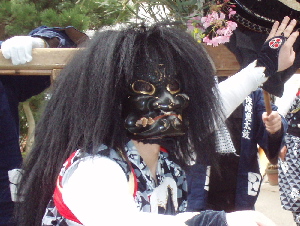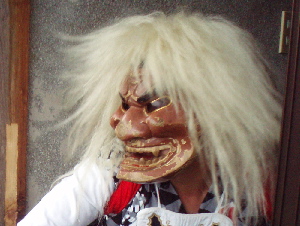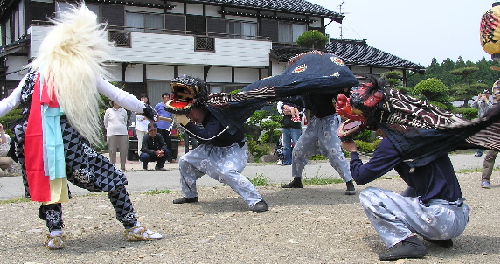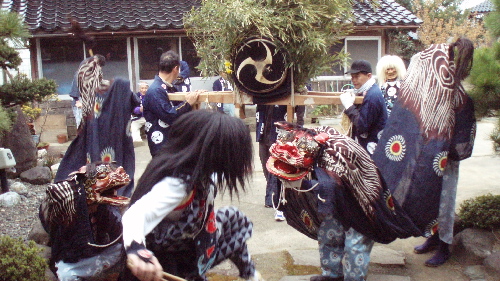A Brief History of the Ondeko (Demon Drum Dance) of Sado Island, Japan


A Brief History of the Ondeko (Demon Drum Dance) of Sado Island, Japan


In spite of the fame and popularity of the traditional performing art of
Sado Island known as Oni-daiko (also called Ondeko, the demon drum dance)
relatively little is known about its origins.
One story is that in the year 877, during the reign of Emperor Yozei, a
Buddhist monk's dance was introduced to the Noto peninsula near Sado Island
from China. Another version has it that it originated from the Tang Lion's
Dance - also from China - in the 8th Century. It gradually transformed
into the Demon Drum Dance as it made its way to Sado.
Today there are about 110 Oni-daiko groups on Sado, classified into 3
genres. The Aikawa type (northern) includes the dance of an old man called
mamemaki who scatters beans for good luck from a wooden measuring box. In
the Kuninaka (central) variety, there are black and white demons (oni)
dancing with 2 lions, and in the Maehama (southern) style, 2 demons dance
together to the accompaniment of flute and drum. There are many variations
in the dancing styles, but all have in common masked demons dancing to
drums.
Funashimo Onidaiko
Sometime between 1716 and 1735 Kiyofusa Ukyo Homma arranged the choreography of a Noh dance into a demon drum dance. At the Katagami Ushio shrine he encouraged the local residents to take part. These are the roots of Fanashimo Ondeko. In the late 1850's Rokusuke Sekiguchi - feeling the dancing style had degenerated - went to Kyoto to study traditional court dance and after teaching 3 generations of pupils, the Katagami style of Ondeko evolved. The Kuninaka style is based on this and it spread throughout the central plain of Sado over the next 60 years or so. In the Taisho period (1912-1925) a talented native of Funashimo embellished the dance, bringing it close to how we know it today. Funashimo Onidaiko is also called the 'Shishi Oni Daiko' because both shishi (lions) and oni (demons) appear.

Every year on April 13, on the day of the Hiyoshi Shrine festival, the troupe move from door to door in the hamlet driving off evil spirits and praying for an abundant harvest. At night they perform one last dance to the gods of the Hiyoshi Shrine in Niibo, after which a portable shrine (mikoshi) leaves the sacred compound to travel through the village to offer protection. The children of the village strike up a band called the Sagariha.
The Funashimo Ondeko group is made up of two people to carry the drum decorated in bamboo leaves and paper lanterns, three rhythm drummers, a male and female demon, and two lions played by two people each. The fearsome demon masks may have originated in Noh theatre or other classical performing arts, but have evolved into their own unique style which vary from troupe to troupe in colour and design. There is a variety of drumbeats played throughout the dance: toyose (stirring), michibiki (guiding), uchikomi (striking), uchikiri (closing), kurebachi ('kure' sticks), hayabachi (fast sticks) and modori taiko (returning drum). Revellers love watching and listening to the variation in drumming styles between the violence when the male demon dances and the softer touch for the female dance.
The Ondeko set begins with the toyose. The demon enters dancing and gradually approaches the drum. When the beat changes to hayabachi the dance becomes wilder. Two lions then emerge and attack the demon, trying to keep him or her from the drum. While fighting off the lions the demon struggles to reach the drum. The degree of skill and dramatic flare with which this heroic struggle is portrayed separates the great dancer from the good.

According to the elders of Funashimo, the Ondeko was formerly only performed on the official festival day. In 1924 however, an exception was made when it was performed at the reception of a group of luminaries including musicologist Hisao Tanabe, poet and novelist Keigetsu Omachi and Prince Kuninomiya After the performance Mr. Tanabe was so enthused he helped spread the word. On April 15th, at the 5th Annual National Folk Performance Contest, Funashimo Onidaiko performed at the Nihon Seinen Kaikan in Tokyo and since that date the demons have been allowed to perform in public on days other than the festival.
It has been 18 years since the the official name of the group was changed from The Young Men's Association, to The Preservation Group. In spite of the keen interest in and support for the group, it hasn't been easy to preserve this and other folk groups in the face of the radical change Japan has known since the war. This is an on-going effort kindled by the passion of each new young generation under the guiding hand of those who have gone before.
Significant Dates in the History of Funashimo Onidaiko
Early 20th Century
Master demon dancers Soichi Morita and Kankichi Kondo develop the Funashimo
style based on the Katagami style Ondeko.
April 5th, 1930
Participation in the 5th Annual All-Japan Folk Performance Contest, after
which the group takes part in numerous public performances.
1950's
Regular performances begin at the Nichiren temple, Konpon-ji. Now
regularly
seen by tourists, Funashimo Ondeko become known throughout Japan.
1967
Participation in the 80th anniversary celebrations of the Japan Red Cross.
1970
Performance at the International Expo in Osaka.
February 1989
Foundation of the Onidaiko Preservation Group.
October 1989
Performance with great Noh theatre master Nomura Mansaku.
August 1990
Performance in the All Japan Oni (Demon) Summit'
September 1991
Performance in Okinawa.
February 2002
Performance at the Rantan Festival in Takao, Taiwan.
March 2005
Performance at Folk Arts of Sado at the National Theatre, Tokyo
